Keywords
|
Hybrid cascaded multilevel converter, Energy storage, power distribution, Ultra-capacitors, motor
drive. |
INTRODUCTION
|
Numerous industrial applications have begun to require high power apparatus in recent years. Multilevel inverters have
become more popular over the years in industrial propel applications and high power applications with the promise of
less disturbances, smaller common-mode voltage, the possibility to function at lower switching frequencies, and good
potential for further developments than ordinary two-level inverters. In multilevel inverters the Cascaded H-Bridge
(CHB) configuration has recently become very popular in high-power AC supplies and adjustable-speed drive
applications. A cascade multilevel inverter consists of a series of H-bridge (single-phase full bridge) inverter units in
each of its three phases. The cascaded multilevel inverter was invented for use in medium to high power applications.
The traditional cascaded multilevel inverter interfaces DC energy sources. |
| The advantages of cascaded multilevel inverters are: |
| ïÃâ÷ Requires less number of components per level. |
| ïÃâ÷ Modularized structure without clamping components. |
| ïÃâ÷ Simple voltage balancing modulation. |
Hybrid cascaded multilevel converters provide an attractive option for high power and high performance motor drive
applications. Traditional H-bridge HCMC use multiple dc sources, but recently, energy storage elements have been
used to replace some of the dc sources, mainly to provide reactive power compensation. Most of the research that has
been conducted on the use of energy storage for motor drive applications is based on the use of converter for interface
between the ultra-capacitors (UC) and the induction motor.
In most applications, a power converter needs to transfer real power from ac to dc (rectifier operation) or dc to ac
(inverter operation). When operating at unity power factor, the charging time for rectifier operation (or discharging
time for inverter operation) for each capacitor is different. Such a capacitor charging profile repeats every half cycle,
and the result is unbalanced capacitor voltages between different levels. The voltage unbalance problem in a multilevel converter can be solved by several approaches, such as replacing capacitors by a controlled constant dc voltage source
such as pulse-width modulation (PWM) voltage regulators or batteries. The use of a controlled dc voltage will result in
system complexity and cost penalties. With the high power nature of utility power systems, the converter switching
frequency must be kept to a minimum to avoid switching losses and electromagnetic interference (EMI) problems.
When operating at zero power factors, however, the capacitor voltages can be balanced by equal charge and discharge
in one-half cycle. This indicates that the converter can transfer pure reactive power without the voltage unbalance
problem. |
PROPOSED TOPOLOGY
|
In this paper, the proposed multilevel inverter not only has the modularity feature of cascaded topologies but also
consists of single dc source and the remaining are of capacitors. Proposed topology is not only used to regulate the
voltage across the capacitors and also used for energy storage purpose with the use of ultra capacitors. |
In this topology, each leg of a standard three-leg converter is connected in series with an H-bridge converter. The threeleg
converter is powered by a dc source while each of the three H-bridges is supplied by a capacitor. While the this
topology has the advantage of utilizing only a single dc power supply. |
CAPACITOR VOLTAGE REGULATION
|
The most important factors causing the voltage imbalance among these DC capacitors are the difference in the power
stage losses and the component tolerances. The internal losses may be differently influenced by the switching and
conduction activity and the component tolerances. To achieve steady-state, balanced voltages, these DC capacitors
must have the same amount of real power utilization in a given period of time. Due to sharing the same output current,
the differences in the capacitor currents are caused by the different duty cycles, because a capacitor current is a product
of a duty cycle and an output current. Therefore, the average switching functions or duty cycles in these H-bridge
converters must be identical. |
The imbalance of DC capacitor voltages will degrade the quality of the voltage output. In severe cases, this could lead
to the complete collapse of the power conversion system. Moreover, it will cause excessive voltages across the devices and an imbalance of switching losses. An adequate control strategy for avoiding the imbalance of DC capacitor
voltages must meet the following requirements. |
| 1) The impact on voltage quality should be as small as possible. |
| 2) It can balance voltages when components of H-bridges have parameter variations. |
| 3) It can balance voltages when H-bridges switch with different switching patterns. |
In the proposed topology, the capacitor voltage regulation is obtained by using a new technique called phase shift
modulation. The principle of operation is explained by the following figure.2 shown below. |
The operation of the capacitor voltage regulation using phase shift modulation is clearly explained as, when the
capacitor is charging, the generated active power in the main cell will be greater than the power transferred to the load
and the remaining power is used charge the capacitor of the auxiliary cell. While when the capacitor is discharging, the
main cell will not supply as much power. Consequently, the capacitor in the auxiliary cell will be discharged. When no phase shifting is applied, the average power that the harmonics send out during a cycle is zero, which therefore does not
contribute to the output power of the cell. Therefore, by controlling Δα we can charge or discharge the capacitor to
regulate its voltage at the desired value. By this principle explained above, clearly shows that capacitor voltage
regulation is effectively achieved by phase shift modulation. |
ENERGY STORAGE
|
Electrical energy storage is emerging as a key technology with applications in areas such as improved reliability and
power quality in the utility sector and other non-stationary power applications, integration of renewable sources into
distributed generation systems, improved energy efficiency and productivity in conventional power generation plants,
and regenerative motor drive systems. Energy storage systems can be characterized by their specific requirements such
as power levels, energy storage capacity, and response time (determined by storage times or discharge times). The
ultra-capacitor as an energy storage device dedicated for power conversion applications. In comparison to state of the
art electrochemical batteries, the ultra-capacitors have higher power density, higher efficiency, longer lifetime and
greater cycling capability. In comparison to the state of the art electrolytic capacitors, the ultra-capacitors have higher
energy density. All these advantages make the ultra-capacitors good candidate for many power conversion applications.
In the proposed topology the cascaded multilevel inverter consists of single dc source, and the remaining are of
capacitors, these capacitors are replaced by the ultra capacitors which are very efficient for energy storage. |
EXPERIMENTAL RESULTS
|
Matlab simulations are employed to validate the proposed method. The experimental results show that the proposed
method can effectively eliminate the specific harmonics, and the output voltage waveforms have low total harmonic
distortion (THD). The output phase voltage of cascaded multilevel inverter for 7-levels is shown in Fig.3. |
| The effective capacitor voltage regulation obtained by using phase shift modulation is shown in figure.4 Below. |
| The proposed topology of induction motor drive parameters are shown in the below figure. |
By this simulation results, we can observe that the capacitor voltage regulation is achieved effectively by using phase
shift modulation. |
CONCLUSION
|
A single-dc-source cascaded H-bridge multilevel converter has been analyzed. A new control method, phase-shift
modulation, is used to regulate the voltage of the capacitors replacing the independent dc sources by capacitors. The
proposed method offers an effective regulation of the capacitor voltage and the energy storage using ultra-capacitors as
they have higher power density, higher efficiency, longer life and greater cycling capability with hybrid cascaded
multilevel inverter topologies for high performance motor drive applications. The experimental results show the
effectiveness of this method of regulating the capacitor and reduce the voltage ripple of the capacitors, which leads to
higher power conversion efficiency with equal power distribution, reduces the initial cost, and complexity hence it is
apt for industrial applications. |
Figures at a glance
|
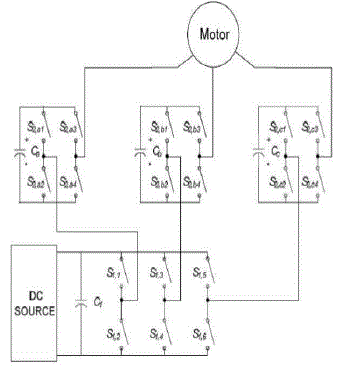 |
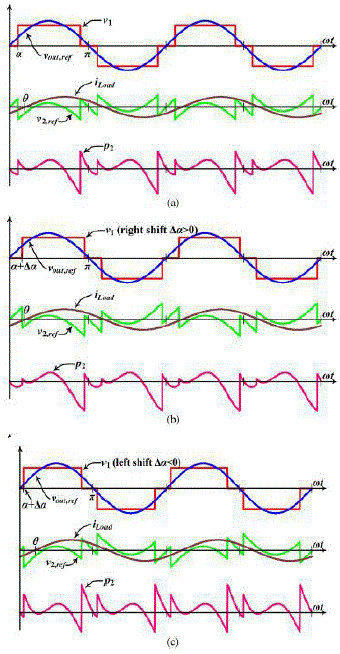 |
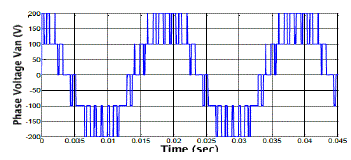 |
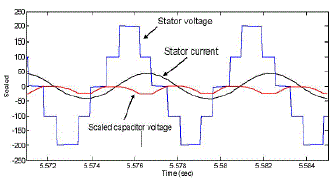 |
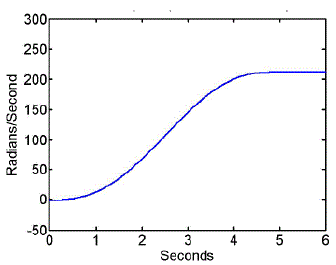 |
| Figure 1 |
Figure 2 |
Figure 3 |
Figure 4 |
Figure 5 |
|
| |
References
|
- S. Srikanthan and M. K. Mishra, âÃâ¬Ãâ¢DC capacitor voltage equalization in neutral clamped inverters for DSTATCOM application,âÃâ¬Ãâ IEEE Trans.Ind. Electron., vol. 57, no. 8, pp. 2768–2775, Aug. 2010.
- J. Zaragoza, J. Pou, S. Ceballos, E. Robles, C. Jaen, and M. Corbalan, âÃâ¬Ãâ¢Voltage-balance compensator for a carrier-based modulation in the neutral-point-clamped converter,âÃâ¬Ãâ IEEE Trans. Ind. Electron., vol. 56, no. 2, pp. 305–314, Feb. 2009.
- J. Liao, K. Wan, and M. Ferdowsi, âÃâ¬Ãâ¢Cascaded H-bridge multilevel inverters—A reexamination,âÃâ¬Ãâ in Proc. IEEE Veh. Power Propulsion Conf., 2007, pp. 203–207.
- M. H. Ameri and S. Farhangi, "A new simple method for capacitors voltage balancing in cascaded H-bridge SSSC," in Proc. Power Electron. and Drive Syst. and Technologies Conf., 2010, pp. 147-151.
- K. A. Corzine and X. Kou, "Capacitor voltage balancing in full binary combination schema flying capacitor multilevel inverters," IEEE Power Electron.Lett., vol. 1, no. 1, pp. 2-5, Mar. 2003.
- H. Sepahvand, M. Khazraei, M. Ferdowsi, and K. A. Corzine, âÃâ¬Ãâ¢Feasibility of capacitor voltage regulation and output voltage harmonic minimization in cascaded H-bridge converters,âÃâ¬Ãâ in Proc. IEEE Appl. Power Electron. Conf. Expo., 2010, pp. 452–457.
- H. Li, K. Wang, D. Zhang, and W. Ren, "Improved performance and control of hybrid cascaded H-bridge inverter for utility interactive renewable energy applications," in Proc. IEEE Power Electron. Specialists Conf., 2007, pp. 2465- 2471.
- H. S. Patel and R. G. Hoft, âÃâ¬Ãâ¢Generalized techniques of harmonic elimination and voltage control in thyristor inverters: Part I harmonic elimination,âÃâ¬Ãâ IEEE Trans. Ind. Appl., vol. IA-9, no. 3, pp. 310–317, May 1973.
- 9. C. A. Silva, L. A. Cordova, P. Lezana, and L. Empringham, "Implementation and control of a hybrid multilevel converter with floating dc links for current waveform improvement," IEEE Trans. Ind. Electron., vol. 58, no. 6, pp. 2304- 2312, Jun. 2011.
- K. Iwaya and I. Takahashi, "Novel multilevel PWM wave control method usingseries connected full bridge inverters," in Proc. IEEE Int. Electric Machines and Drives Conf., 2003, vol. 3, pp. 1543-1548.
- Y.-M. Park, J.-Y.Yoo, and S.-B. Lee, "Practical implementation of PWM synchronization and phase-shift method for cascaded H-bridge multilevel inverters based on a standard serial communication protocol," IEEE Trans. Ind. Appl., vol. 44, no. 2, pp. 634-643, Mar. 2008.
- J. A. Ulrich and A. R. Bendre, "Floating capacitor voltage regulation in diode clamped hybrid multilevel converters," in Proc. IEEE Electric Ship Technologies Symp., 2009, pp. 197-202.
- S. Fukuda and Y. Matsumoto, âÃâ¬Ãâ¢Optimal regulator based control of NPC boost rectifiers for unity power factor and reduced neutral point potential variations,âÃâ¬Ãâ in Proc. 32nd IEEE IAS Annu. Meeting Ind. Appl. Conf., Oct. 5–9, 1997, vol. 2, pp. 1455–1462.
- N. Celanovic and D. Borojevic, âÃâ¬Ãâ¢A comprehensive study of neutral-point voltage balancing problem in three-level neutral-point-clamped voltage source PWM inverters,âÃâ¬Ãâ in Proc. 14th Annu. Appl. Power Electron. Conf. Expo., Mar 14–18, 1999, vol. 1, pp. 535–541.
- O. Alonso, L. Marroyo, P. Sanchis, E. Gubia, and A. Guerrero, âÃâ¬Ãâ¢Analysis of neutral-point voltage balancing problem in three-level neutralpointclampedinverters with SVPWM modulation,âÃâ¬Ãâ in Proc. 28th Annu. IEEE Ind. Electron. Soc.Conf.] Nov. 5–8, 2002, vol. 2, pp. 920–925.
|